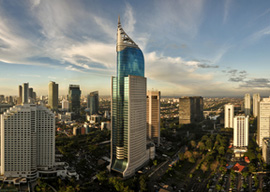
September 20, 2012

Jakarta, Indonesia
JAKARTA“Anies Baswedan, the brilliant and thoughtful young president of Paramadina University here in this capital city, beams as he describes Indonesia Mengajar (Teach Indonesia). Similar to the Teach For America program in the United States, Baswedan’s initiative sends dedicated young Indonesians to remote regions of this sprawling archipelago to educate their impoverished countrymen.
“It brings enormous value to them,” Baswedan tells me. “We recruit them and then provide seven weeks of teacher training and then army survival training before they are deployed.”
Survival training? Deployed?
Therein lies the dual challenge for Southeast Asia’s largest and fastest-growing economy. Often working without the benefit of roads, running water, electricity, or the Internet, these young volunteer teachers must contend not only with the country’s lagging education system, but also with a creaking infrastructure better suited to the Dutch colony it once was than the G20 member it now is.
For the government of President Susilo Bambang Yudhoyono, determined to join the ranks of the world’s truly advanced democracies, the “three Rs” of modernization may as well be reading, writing, and road-building.
Only a third of Indonesian students complete nine full years of basic education. Funding mysteriously goes missing, and rundown school buildings collapse. “There are too many deadwood teachers,” one official tells me, noting that a recent examination to determine teacher salary increases was corrupted.
Not one of Indonesia’s 3,000 private and nearly 100 public universities is in the top 400 globally”yet cheating to gain entrance to them is still widespread. The affluent simply study overseas, with an estimated 32,000 currently taking their talents to countries such as Australia, Malaysia, or the US. Summing up the country’s educational underperformance, the Jakarta Globe recently observed that “Indonesia’s creaking university system is failing to keep pace with its booming economy, struggling to produce graduates equipped for modern working life in the Southeast Asian nation.”
The problems with Indonesia’s human infrastructure are matched by its physical infrastructure. In a far-flung archipelago comprised of 13,500 islands and 750 dialects, Indonesia’s motto, “Unity in Diversity,” requires building bridges, as well as roads, ports, airports, dams, and power plants. Indonesia grew at a remarkably robust 6.4 percent last quarter, faster than any other major emerging market economy except China”making an argument that the lauded and emerging BRIC economies of Brazil, Russia, India, and China should become “iBRIC.” Yet as Indonesia’s GDP has grown to become the world’s 16th-largest, spending on infrastructure as a percentage of GDP has actually dropped since 1997, from eight percent to just three percent.
Consequently, companies spend an astonishing 30 percent of their production costs on transportation, meaning that Indonesia’s businesses are stalling against its infrastructure constraints much like the souped-up engines of the late-model BMWs that sit conspicuously on Jakarta’s notoriously gridlocked streets. A Member of Parliament tells me, “We haven’t built a dam in 30 years,” and some of the rapidly proliferating airlines are so shoddy that cell phones can interfere with air-traffic control. The frustration is obvious when Bambang Harymurti, editor of Tempo magazine, tells me, “It costs three times more to send a container from Jakarta to Padang [in other words, from one Indonesian city to another] than it does to send it to Singapore.”